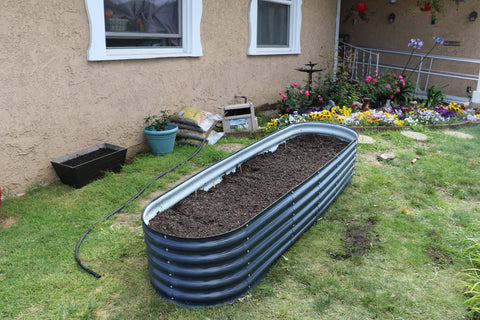6 Ways from Olle Garden Bed To Compost In Winter
For many people, winter is about comfortable open flames, slippers and curling up inside. Few people think about their gardens in winter, let alone composting. However, when spring finally arrives, winter composting can give your garden and soil a good start. Please continue to read for tips and hints to help you compost throughout the year and maximize free soil improvement while minimizing the impact on the environment. Here are 6 ways from Olle Garden Bed to make the most of your compost in winter.
We are used to making our gardens ready for winter; Protect delicate plants, protect pots, trim and tidy. So why not do the same for your compost pile? With a few simple changes, you can help your compost pile stay active throughout the cold winter.

1.Close the cover!
Excess water may be a problem with the compost heap. Simply put a lid or roof over the compost pile, and you can help protect your compost from unnecessary precipitation.
2.Cover it!
Placing waterproof cloth on the compost pile can not only take away unwanted precipitation, but also help to control the internal heat of the compost in the place you want - the pile.
3.Protect it!
Placing your car in a shed or garage usually helps protect it from frost. You can do the same for the compost heap. If you usually use compost, build a simple protective structure around it.
4.Be selective!
In summer, you may be happy to add some vegetable and fruit peels to the compost heap. However, due to the slow decomposition rate in winter, these food residues will attract unwanted rodents and other visitors to your compost pile. Look for alternatives such as bokashi compost and earthworm compost for your food residues to keep these attractants away from your compost pile; More information follows.
5.Make it bigger!
Bacteria and life in the center of a healthy compost heap will cause it to heat up and remain active in the cold winter. It is the edge of your pile exposed to elements in winter, which will become cold and inactive. The bigger your stake, the longer it will stay active in the cold. A good rule of thumb to remember is that stakes should be at least one cubic yard.
6. Tear it up!
Chopping the material before adding it to the pile has been shown to heat the pile more evenly and protect it from the cold outside temperature.
I hate three things about outdoor composting in winter
Overwintering the compost pile will help increase the active time of the compost pile throughout the year. However, composting in winter can still be a drag. Here are three things that many of us hate most about composting in winter:

1. Travel to compost pile
Bringing food waste to the compost pile does not seem so attractive in the dark, cold, snow and damp. Instead, use the indoor composting method to store and compost all food waste in winter, and you will no longer have winter to go to the compost heap.
2. Pests
In cold winter, compost piles are usually warm and rarely disturbed areas in the garden. This makes them a good home for rats, mice and other harmful pests. Any food waste you add to the pile in winter will take a long time to decompose and will become an important food source for local wildlife. Warm, quiet and food means that your compost pile will soon become a safe haven for local pest populations.
Reduce pest problems:
Limit the waste of food you add to the pile in winter. Bokashi compost or earthworm compost is an excellent pest free solution for food waste;
Add spiny branches and shrubs (such as holly) around the compost pile;
Rotate your pile regularly (assuming it is not frozen!) To disturb the wild animals.
3. There is no space in the compost box
As the temperature decreases, you will also notice a decrease in the rate of decomposition in the compost heap. This means that any material you add in winter can sit there until spring warms up. Ensure that sufficient space is left in the compost pile to accommodate any material that may be produced in winter. Or, make a separate pile. Once your pile becomes more active in spring, it will be added to your compost pile.
Composting becomes simple in winter
With a few changes, you can keep compost in winter for garden and yard waste. However, you are unlikely to successfully compost all food residues in this way throughout the year without attracting pests. But don't worry; Here are two good alternative composting methods that can help you compost all your food waste throughout the year. The additional benefit is that they all occur in warm, dry and snow free rooms!
Bokashi Compost
A good choice for composting all food waste throughout the year is Bokashi composting. Bokashi composting is a fermentation process that can quickly and easily convert food waste into high-yield compost. The key of Bokashi process is fermentation. Through fermentation, Bokashi compost produces specialized microorganisms, yeasts and fungi, which are the main components of a healthy and productive soil structure.
Using Bokashi composting eliminates many of the challenges associated with "traditional" composting, and most of the process can be done easily in your kitchen. Although traditional backyard compost is only applicable to selected food residues, Bokashi compost is applicable to all food residues: cooked food, dairy products, meat, cereals, pasta, fruits and vegetables, etc.
If you are interested in Bokashi composting method, please visit Bokashi Life anytime.
Earthworm compost
The second option for indoor composting is earthworm compost or worm compost. Like Bokasi Compost, earthworm compost is suitable for small space, and worm composter can be stored indoors. Worms will consume your kitchen waste and produce a fertile mixture of worm feces and food waste decomposition.